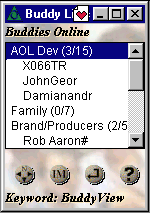Patents
Barry Appelman authored 77 patents. [1]

Barry Appelman | |
|---|---|
| Born | US |
| Known for | Instant Messaging, TCP/IP |
| Awards | IBM CEO Outstanding Technical Achievement Award |
Barry Appelman is recognized as being the father of the "buddy list" and AOL instant messenger. Companies had been using crude forms of Instant messaging within their own networks for over forty years, but the idea of presence, i.e. who is logged on at any given time, was non existent. It was not until Appelman, and his colleagues at the Thomas Watson Research Center, first began to write programs on the mainframe system letting each other know when they were actually online, that modern day Instant Messaging was born.
In 1994 while employed at AOL, Appelman hired a single contract programmer, Stephen D. Williams, and for five months they worked together building a prototype system that allowed AOL subscribers to have an early form of the buddy list.
In 1995 AIM was launched internally to AOL employees. It was initially dubbed "the stalker feature" since many employees were uncomfortable having their co-workers know when they were online. AOL decided to make Appelman's system available to its subscribers in March 1996, then to other Internet users in May 1997. Ten years later, there were over 53 million AIM users worldwide.
Appelman joined AOL in 1993 to head up all of AOL server and host development efforts. He authored many innovations and patents: an instant messaging system, a highly scalable email system, ad servers, TCP/IP enabled browsers, among many others. Barry Appelman and his former colleagues from T.J. Watson, Matt Korn and Mike Connors who also came to AOL, were crucial to taking AOL from a distant third position in online services to that of a formidable leadership within 2–3 years.
Barry Appelman led IBM's foray into TCP/IP at the Thomas Watson Research Center from 1984 until 1993. Appelman was able to turn complicated IBM politics to the advantage of TCP/IP, open systems and Internet standards. This was not an easy endeavor given that at the time IBM was pushing hard a competing family of internal protocols called Systems Network Architecture. In the end, the work of Barry Appelman proved critical to the IBM's adoption of TCP/IP and its early embrace of the Internet. Mr. Appelman and his group were active in the Internet standardization. Yakov Rekhter authored several Internet RFCs in routing protocols. Mr Appelman's team was also active in SNMP standardization.
Appelman's small team of developers produced TCP/IP stacks for all IBM operating systems. Dean Hiller authored MVS TCP/IP. Jay Elinsky authored TCP/IP for VM/CMS. Yakov Rekhter authored TCP/IP for AIX. Oleg Vishnepolsky authored TCP/IP for OS/2 and IBM POS terminals. Appelman was one of the first in the industry to recognize the importance of security in the world of open systems. He was the first one to make Kerberos security system out of MIT's Project Athena a commercial product by having Galina Kofman port this security software to various OS. Kofman also did FTP for VM/CMS. Dick Ryniker authored NFS for VM/CMS and MVS.
Appelman's innovation included offloading of TCP/IP processing from IBM mainframes to OS/2 servers, graphical TCP/IP clients, SNMP and FTP APIs, fastest terminal emulator MYTE, S2 Spreadsheet that connected via TCP to IBM DB2, and many others. Particularly noteworthy was the innovation by Appelman and one of his development managers Matt Korn to get voice and video flowing over IP back in 1987.
Barry Appelman authored 77 patents. [1]

The Internet protocol suite, commonly known as TCP/IP, is a framework for organizing the set of communication protocols used in the Internet and similar computer networks according to functional criteria. The foundational protocols in the suite are the Transmission Control Protocol (TCP), the User Datagram Protocol (UDP), and the Internet Protocol (IP). Early versions of this networking model were known as the Department of Defense (DoD) model because the research and development were funded by the United States Department of Defense through DARPA.

Multiple Virtual Storage, more commonly called MVS, is the most commonly used operating system on the System/370, System/390 and IBM Z IBM mainframe computers. IBM developed MVS, along with OS/VS1 and SVS, as a successor to OS/360. It is unrelated to IBM's other mainframe operating system lines, e.g., VSE, VM, TPF.

VSEn is an operating system for IBM mainframe computers, the latest one in the DOS/360 lineage, which originated in 1965. It is less common than z/OS and is mostly used on smaller machines.

z/OS is a 64-bit operating system for IBM z/Architecture mainframes, introduced by IBM in October 2000. It derives from and is the successor to OS/390, which in turn was preceded by a string of MVS versions. Like OS/390, z/OS combines a number of formerly separate, related products, some of which are still optional. z/OS has the attributes of modern operating systems but also retains much of the older functionality that originated in the 1960s and is still in regular use—z/OS is designed for backward compatibility.

OS/390 is an IBM operating system for the System/390 IBM mainframe computers.

VM is a family of IBM virtual machine operating systems used on IBM mainframes System/370, System/390, zSeries, System z and compatible systems, including the Hercules emulator for personal computers.
Interlink Computer Sciences, of Fremont, California, was a developer of hardware and software that allowed IBM mainframe computers running the MVS operating system to be connected to non-IBM networks.
Remote job entry, or Remote Batch, is the procedure for sending requests for non-interactive data processing tasks (jobs) to mainframe computers from remote workstations, and by extension the process of receiving the output from such jobs at a remote workstation.
In computing, Advanced Program to Program Communication or APPC is a protocol which computer programs can use to communicate over a network. APPC is at the application layer in the OSI model, it enables communications between programs on different computers, from portables and workstations to midrange and host computers. APPC is defined as VTAM LU 6.2
Since the rise of the personal computer in the 1980s, IBM and other vendors have created PC-based IBM-compatible mainframes which are compatible with the larger IBM mainframe computers. For a period of time PC-based mainframe-compatible systems had a lower price and did not require as much electricity or floor space. However, they sacrificed performance and were not as dependable as mainframe-class hardware. These products have been popular with mainframe developers, in education and training settings, for very small companies with non-critical processing, and in certain disaster relief roles.
Connect:Direct—originally named Network Data Mover (NDM)—is a computer software product that transfers files between mainframe computers and/or midrange computers. It was developed for mainframes, with other platforms being added as the product grew. NDM was renamed to Connect:Direct in 1993, following the acquisition of Systems Center, Inc. by Sterling Software. In 1996, Sterling Software executed a public spinoff of a new entity called Sterling Commerce, which consisted of the Communications Software Group (the business unit responsible for marketing the Connect:Direct product and other file transfer products sourced from the pre-1993 Sterling Software (e.g. Connect:Mailbox)) and the Sterling EDI Network business. In 2000, SBC Communications acquired Sterling Commerce and held it until 2010. AT&T merged with SBC effective November 2005. In 2010, IBM completed the purchase of Sterling Commerce from AT&T.
VP/CSS was a time-sharing operating system developed by National CSS. It began life in 1968 as a copy of IBM's CP/CMS, which at the time was distributed to IBM customers at no charge, in source code form, without support, as part of the IBM Type-III Library. Through extensive in-house development, in what today would be termed a software fork, National CSS took VP/CSS in a different direction from CP/CMS. Although the two systems would eventually share many capabilities, their technical implementations diverged in substantive ways.
Yakov Rekhter is a well-known network protocol designer and software programmer. He was heavily involved in internet protocol development, and its predecessors, from their early stages.

Operating System/Virtual Storage 1, or OS/VS1, is a discontinued IBM mainframe computer operating system designed to be run on IBM System/370 hardware. It was the successor to the Multiprogramming with a Fixed number of Tasks (MFT) option of System/360's operating system OS/360. OS/VS1, in comparison to its predecessor, supported virtual memory. OS/VS1 was generally available during the 1970s and 1980s, and it is no longer supported by IBM.
BITNET was a co-operative U.S. university computer network founded in 1981 by Ira Fuchs at the City University of New York (CUNY) and Greydon Freeman at Yale University. The first network link was between CUNY and Yale.
InterCon Systems Corporation was founded in April 1988 by Kurt D. Baumann and Mikki Barry to produce software to connect Macintosh computers in environments that were not Macintosh-exclusive. At the time, there was no real concept of the Internet and there was still a question of whether the TCP/IP protocols or OSI protocols would be adopted widely. Over the next 9 years, the company grew from three employees to over 100 and sold software in the US, Europe and Japan.
S2 Spreadsheet was a Lotus 1-2-3 compatible spreadsheet developed by IBM in 1984. It had all the features of Lotus 1-2-3, plus it had an ability to connect to IBM mainframes via TCP/IP and pull data from IBM databases such as IBM DB2 and IBM SQL/DS. It also had features that allowed for easy visual connection between formulas and their dependencies - those features were later adopted by Lotus 1-2-3 and Microsoft Excel. S2 was developed almost concurrently with Lotus development of 1-2-3, and matched 1-2-3 feature for feature. The S2 program was used throughout IBM in 1980s and 1990s. In 1986 it caused a legal controversy within IBM because of then current look-and-feel lawsuits between Lotus and other companies, and most importantly because IBM was negotiating a high-profile deal with Lotus to market Lotus 1-2-3.
Galina Kofman is a computer scientist and business executive. She was the author of the Kerberos protocol for various IBM systems. Kofman also authored FTP for IBM VM/CMS and OS/2. She received two IBM CEO Outstanding Technical Achievements awards and holds a patent on grid applications. Kofman is an executive at Recyclebank, a green company that rewards people for recycling.
The European Academic and Research Network (EARN) was a computer network connecting universities and research institutions across Europe, and was connected in 1983 via transatlantic circuits and a gateway funded by IBM to BITNET, its peer in the United States.
Archived 2008-05-09 at the Wayback Machine